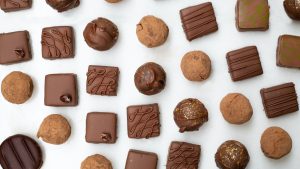Chocolate is an indulgence enjoyed by millions of people worldwide. It’s a simple pleasure that brings joy and comfort, yet the process of transforming cocoa beans into a delicious bar of chocolate is anything but simple. In fact, it’s a complex symphony of chemistry that can be appreciated all the more when we delve into the intricate intricacies of how it’s made. The allure of chocolate is not just due to its delicious taste, but also the fascinating chemistry that lies behind its creation. A deeper understanding of this chemistry can provide a greater appreciation of the flavors, textures, and aromas that make chocolate such a beloved treat.
The Complex Chemistry of Chocolate:



The production of chocolate involves a series of intricate chemical reactions that transform the humble cocoa bean into a treat that tantalizes our taste buds. Cocoa beans are a treasure trove of chemical compounds, each playing a role in contributing to the final flavor and aroma of chocolate. These compounds include polyphenols, flavan-3-ols, proanthocyanidins, methylxanthines, aldehydes, esters, ketones, pyrazines, acids, and alcohols, among others. Each of these compounds interacts with one another during the chocolate-making process, resulting in the unique sensory experience that we associate with chocolate.
For example, polyphenols, particularly flavan-3-ols and proanthocyanidins, contribute to the bitterness and astringency of chocolate. These compounds are also responsible for the brown color and potential health benefits of chocolate. Meanwhile, methylxanthines, such as caffeine and theobromine, provide the mild stimulating effect often associated with consuming chocolate. Aldehydes, esters, and ketones, on the other hand, contribute to the fruity and floral aromas of chocolate, while pyrazines add a nutty and roasted flavor.
The interplay of these compounds is delicate and complex, with each one playing a critical role in the final taste profile of chocolate. It’s a balancing act, with the precise combination and ratio of these compounds determining whether a chocolate will have a smooth, milky sweetness or a robust, dark bitterness. This intricate chemistry is the heart of the chocolate-making process, with chocolatiers often spending years perfecting their recipes to achieve the perfect blend of flavors and aromas.
Fermentation and Chocolate Production:
One of the first steps in the chocolate-making process is fermentation. This is a crucial stage that sets the foundation for the development of flavor and aroma in the cocoa beans. During fermentation, the proteins in the cocoa beans undergo hydrolysis, resulting in an increase in free amino acids and oligopeptides. These compounds are precursors to a variety of flavor compounds that contribute to the unique taste of chocolate.
For instance, the amino acid phenylalanine is converted into the aromatic compound phenethyl alcohol during fermentation, which contributes to the floral and fruity flavors in chocolate. Similarly, the breakdown of proteins also leads to the formation of volatile compounds, such as aldehydes and esters, that contribute to the overall aroma of chocolate.
The process of fermentation is one of the most critical stages in chocolate production. Not only does it play a significant role in flavor development, but it also influences the texture and color of the final product. The duration and temperature of fermentation can affect the concentration of flavor compounds, with longer fermentation times and higher temperatures promoting the formation of more complex and intense flavors. Understanding and controlling the fermentation process is therefore a key aspect of creating high-quality chocolate with a desirable flavor profile.
Roasting and the Maillard Reaction:
After fermentation, the cocoa beans are subjected to roasting, a process that significantly influences the flavor and aroma of the final chocolate product [1,3]. This involves exposing the beans to high temperatures, which triggers the Maillard reaction, a chemical reaction between amino acids and reducing sugars. This reaction results in the formation of a multitude of aroma compounds that give chocolate its characteristic flavor [1,3].
During roasting, the amino acids react with reducing sugars, such as glucose and fructose, to form a wide variety of volatile compounds, including pyrazines, furans, and lactones. Pyrazines, for instance, contribute to the nutty and roasted flavors in chocolate, while furans and lactones add sweetness and creaminess. The Maillard reaction also results in the browning of the cocoa beans, further enhancing the color and appearance of the final chocolate product.
The degree of roasting can greatly influence the flavor profile of the final product. Light roasts usually yield a more fruity and acidic flavor, while a darker roast tends to bring out more robust, intense flavors with a hint of bitterness and astringency. By understanding and controlling the Maillard reaction during roasting, chocolatiers can manipulate the flavors and aromas of their chocolate, creating unique and complex taste profiles that cater to a wide range of palates.
Lipids and Texture in Chocolate:
Another aspect of the chemistry of chocolate involves the lipids, specifically triacylglycerols, which significantly contribute to the texture and mouthfeel of the final product. These lipids are present in the cocoa beans and become part of the chocolate during the manufacturing process.Cocoa butter, the primary lipid in cocoa beans, consists of fatty acids such as oleic acid, stearic acid, and palmitic acid. These fatty acids influence the melting point of the chocolate, which in turn impacts its texture and mouthfeel.
Cocoa butter is unique in that it can exist in six different crystal forms, each with a different melting point. The form that the cocoa butter takes can significantly impact the texture of the chocolate. When cocoa butter is in the correct crystal form, it gives the chocolate a smooth and glossy appearance, a firm snap when broken, and a creamy, melt-in-your-mouth texture. If the cocoa butter is in the wrong crystal form, it can lead to a grainy texture and a dull appearance, a condition known as “bloom”.
The control of cocoa butter crystallization is an art in itself, and it involves a process known as tempering. Tempering is a method of heating and cooling chocolate that encourages the cocoa butter to crystallize in the correct form, ensuring a smooth texture and a glossy appearance. Understanding the chemistry of lipids and their impact on the texture of chocolate is essential for producing high-quality chocolate that not only tastes good but also has a satisfying mouthfeel.
Chocolate Composition and Variety:
The composition of chocolate can vary widely, with different types of chocolate having distinct ingredients that contribute to their unique flavors and textures. For instance, white chocolate is made primarily from cocoa butter and does not contain any cocoa solids. As a result, it has a creamy, buttery flavor and a smooth texture. On the other hand, milk chocolate and dark chocolate incorporate whole cacao beans, including both the cocoa solids and the cocoa butter. This results in a more complex flavor profile, with the cocoa solids contributing a deep, robust cocoa flavor.
The proportion of cocoa solids and cocoa butter, along with the addition of other ingredients such as sugar and milk, can significantly influence the flavor, texture, and appearance of the final chocolate product. For example, dark chocolate typically contains a high proportion of cocoa solids, which gives it a rich, intense cocoa flavor and a slightly bitter taste. Milk chocolate, on the other hand, contains a lower proportion of cocoa solids, with the addition of milk powder or condensed milk giving it a sweeter, creamier flavor and a softer texture.
Moreover, the origin and variety of the cocoa beans used can also impact the flavor of the chocolate. Cocoa beans from different regions have distinct flavor profiles, with some beans producing chocolate with fruity or floral notes, while others yield chocolate with earthy or nutty flavors. By understanding and manipulating the composition of their chocolate, chocolatiers can create a wide variety of chocolates, each with its unique taste and texture.
Exploring the Health Benefits of Chocolate:
In addition to its delightful flavor and texture, chocolate has been associated with a range of potential health benefits. For instance, cocoa beans are a rich source of essential minerals such as magnesium, potassium, calcium, and iron. These minerals are important for various bodily functions, including muscle function, nerve transmission, and red blood cell production.
Moreover, several studies have suggested a correlation between chocolate consumption and lower risks of high blood pressure and insulin resistance. These benefits are thought to be largely due to the flavanols present in cocoa, which have antioxidant properties and can help improve blood flow and lower blood pressure.
However, it’s important to note that not all chocolates are created equal when it comes to health benefits. Dark chocolate, which contains a high proportion of cocoa, is typically richer in flavanols and other beneficial compounds compared to milk chocolate or white chocolate. It’s also worth noting that while chocolate can be part of a healthy diet, it should be consumed in moderation due to its high sugar and fat content.
Unraveling the Science of Chocolate Flavor:



Creating a great-tasting chocolate product isn’t just about selecting high-quality cocoa beans or perfecting the fermentation and roasting processes. It’s also about balancing the bitter flavors inherent in cocoa with the right amount of sweeteners. The addition of sugar helps to counteract the bitterness of the cocoa, resulting in a more palatable product.
However, the type and amount of sweetener used can significantly impact the overall composition and mouthfeel of the chocolate. For instance, sugar alcohols or stevia powder can be used as low-calorie alternatives to sugar. However, these sweeteners can alter the texture of the chocolate, with sugar alcohols such as erythritol creating a cooling effect in the mouth, which can change the overall sensory experience of the chocolate.
In addition to sweeteners, other ingredients such as vanilla, spices, nuts, or fruits can be added to further enhance or complement the flavor of the chocolate. These additions contribute their own array of flavor compounds, which interact with the compounds in the chocolate to create a complex flavor profile. Understanding these interactions is key to creating a balanced and harmonious flavor in chocolate.
The Art of Tempering Chocolate:
Tempering is a critical step in the chocolate-making process. It involves carefully heating and cooling the chocolate to control the crystallization of the cocoa butter. Proper tempering is essential to achieve the desired glossy finish and firm snap in the final chocolate product. It also helps to prevent blooming, a condition where the cocoa butter separates from the rest of the ingredients and rises to the surface, resulting in a white, powdery appearance and a grainy texture.
The tempering process requires precise control of temperature. The chocolate is first heated to melt all the cocoa butter crystals, then cooled to allow the desirable form of cocoa butter crystals to form, and finally gently reheated to eliminate any undesirable crystals. This process ensures that the cocoa butter crystallizes in a stable form, resulting in a finished chocolate product with a beautiful sheen, a smooth texture, and a satisfying snap when broken.
Achieving the perfect temper can be a challenge, as it requires a deep understanding of the properties of chocolate and careful control of temperature. However, when done correctly, it can greatly enhance the quality of the final chocolate product. The art and science of tempering is one of the many ways that the chemistry of chocolate can be harnessed to create an exquisite eating experience.
The Fascinating History and Consumption of Chocolate:
- Chocolate has a rich and fascinating history, tracing its roots back to the ancient Mayans and Aztecs, who considered it a divine gift and used it in religious ceremonies.
- Today, chocolate is enjoyed by people around the world, with the average American consuming approximately 20 pounds of chocolate per year.
- The enduring popularity of chocolate across different cultures and time periods is a testament to its delightful taste and the pleasure it brings.
- Every step of the chocolate-making process, from the fermentation of the cocoa beans to the tempering of the finished product, involves intricate chemical reactions that contribute to the final flavor, texture, and appearance of the chocolate.
- Understanding this chemistry can provide a deeper appreciation of the art and science of chocolate making.
- It can also inspire us to further explore and experiment with different ingredients, processes, and techniques, in pursuit of new and exciting chocolate creations.
The Impact of Conching on Chocolate Production:
- Conching is another critical step in the chocolate-making process that has a significant impact on the texture and flavor of the final product.
- Named after the shell-like shape of the original conching machines, this process involves grinding and kneading the chocolate for several hours to several days.
- The friction and heat generated during conching help to reduce the size of the cocoa and sugar particles, resulting in a smoother texture.
- In addition to refining the texture, conching also helps to develop the flavor of the chocolate.
- The heat generated during conching promotes the evaporation of volatile compounds, reducing unwanted flavors and aromas.
- It also encourages the reaction between sugar and milk proteins (if milk chocolate is being made), enhancing the sweetness and creaminess of the chocolate.
- During conching, additional cocoa butter can be added to the chocolate to further enhance its smoothness and mouthfeel.
- The amount of cocoa butter added depends on the desired texture and fluidity of the final product.
- Too little cocoa butter can result in a chocolate that is too thick and difficult to mold, while too much can lead to a chocolate that is too soft and lacks a satisfying snap.
- Understanding and controlling the conching process is crucial in chocolate making.
- It allows chocolatiers to adjust the texture and flavor of their chocolate to their exact specifications, ensuring a high-quality product that delivers a superior eating experience.
Examining the Impact of Chocolate on Brain Function:
As well as being a treat for the taste buds, consuming chocolate can also have effects on brain function. This is largely due to the presence of compounds such as theobromine and caffeine, which have stimulating effects on the brain. For example, theobromine can increase heart rate and stimulate the central nervous system, providing a mild pick-me-up effect.
In addition to theobromine and caffeine, chocolate also contains phenylethylamine, a compound that can trigger the release of endorphins and dopamine in the brain. These neurotransmitters are associated with feelings of pleasure and happiness, which may explain why consuming chocolate can often lift our mood.
However, it’s not just the individual compounds in chocolate that can influence brain function. The combination of sugar and chocolate’s high-fat content also activates the reward centers in our brains, which may be the main reason for chocolate cravings. This reward response is a powerful driver of behavior and can lead to the habitual consumption of chocolate.
While the effects of chocolate on brain function are fascinating, it’s important to enjoy chocolate in moderation. Too much chocolate, especially the kinds high in sugar and fat, can lead to health problems such as obesity and diabetes. As with all foods, balance is key.
The Debate Over Chocolate’s Health Benefits:
There has been much debate and research surrounding the potential health benefits of chocolate. While it’s clear that chocolate contains a variety of bioactive compounds, such as flavanols and methylxanthines, the health implications of these compounds are less clear.
Some studies suggest that the flavanols in cocoa can have beneficial effects on heart health, such as lowering blood pressure and improving blood flow. However, these studies often use high concentrations of flavanols, far greater than what would be found in a typical bar of chocolate. Furthermore, the flavanol content of chocolate can vary widely depending on the type of chocolate and the way it’s processed.
The presence of antioxidants in chocolate has also been a focus of research. Antioxidants can neutralize harmful free radicals in the body and are thought to have potential health benefits. However, the quantity of antioxidants in chocolate is unclear, and the chocolate-making process may reduce their amount.
In conclusion, while chocolate contains various compounds that could potentially offer health benefits, more research is needed to substantiate these claims. It’s also important to remember that chocolate is often high in sugar and fat, which can have negative health effects if consumed in excess. Therefore, while it’s okay to enjoy chocolate as part of a balanced diet, it’s best not to view it as a health food.
Conclusion:
The world of chocolate is a fascinating blend of art and science. From the intricate chemical reactions that occur during fermentation and roasting, to the delicate balance of flavors achieved through careful formulation and processing, the creation of chocolate is a testament to the marvels of chemistry. By understanding the diverse flavors and characteristics derived from this chemistry, we can truly appreciate the complexity and depth of chocolate. Through continued exploration and research, we can look forward to new discoveries and innovations in the captivating world of chocolate.

